Thank you for following and for your support! We’re committed to keeping the conversation on this platform open, honest, and grounded in solidarity.
25.06.2025 20:27 — 👍 0 🔁 0 💬 0 📌 0
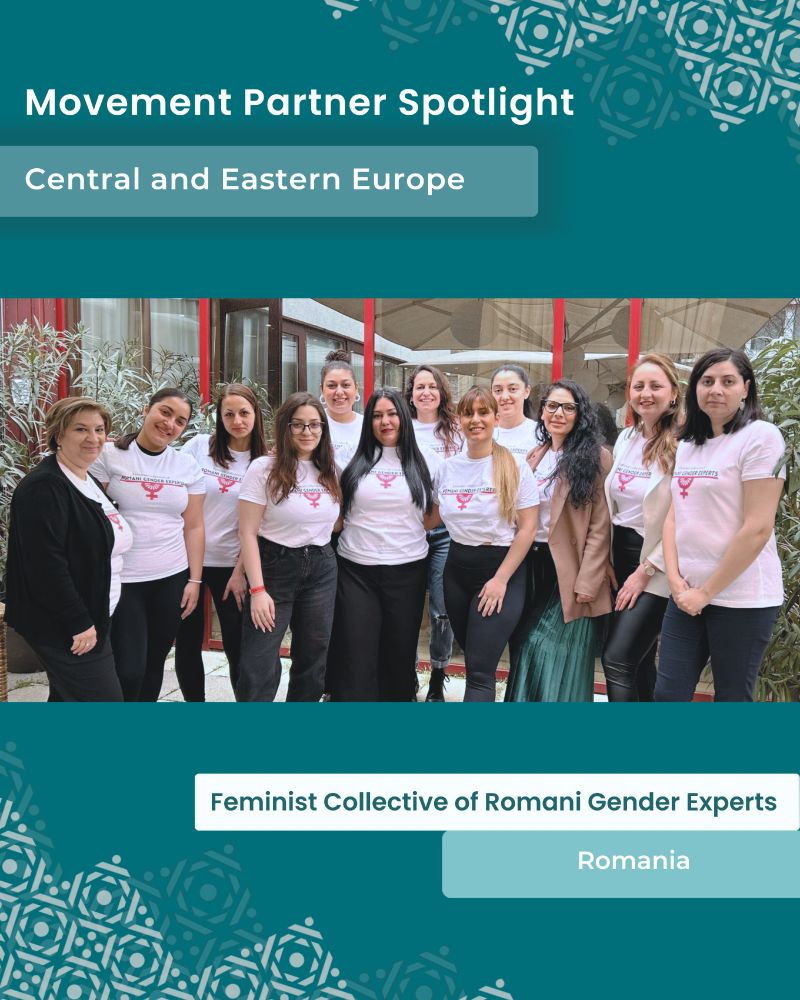
A graphic titled “Movement Partner Spotlight” with a teal background featuring decorative Kurak-like patterns in the corners. The top section includes the labels “Movement Partner Spotlight” and “Central and Eastern Europe.” In the center is a group photo of twelve women wearing matching white t-shirts that read “Romani Gender Experts” with a pink feminist symbol — a stylized combination of a traditional Romani wheel and the female gender symbol. They are standing together in an outdoor courtyard with red-framed windows and beige umbrellas behind them. At the bottom of the image, two rectangular banners appear: a white one with the text “Feminist Collective of Romani Gender Experts” and a light teal one beneath it reading “Romania.”
🧶 Meet the Feminist Collective of Romani Gender Experts — a transnational, feminist, anti-racist network advancing gender equality and intersectional racial justice for Romani women and racialised communities across Central and Eastern Europe.
▶ www.romanifeministcollective.com
25.06.2025 14:08 — 👍 0 🔁 0 💬 0 📌 0
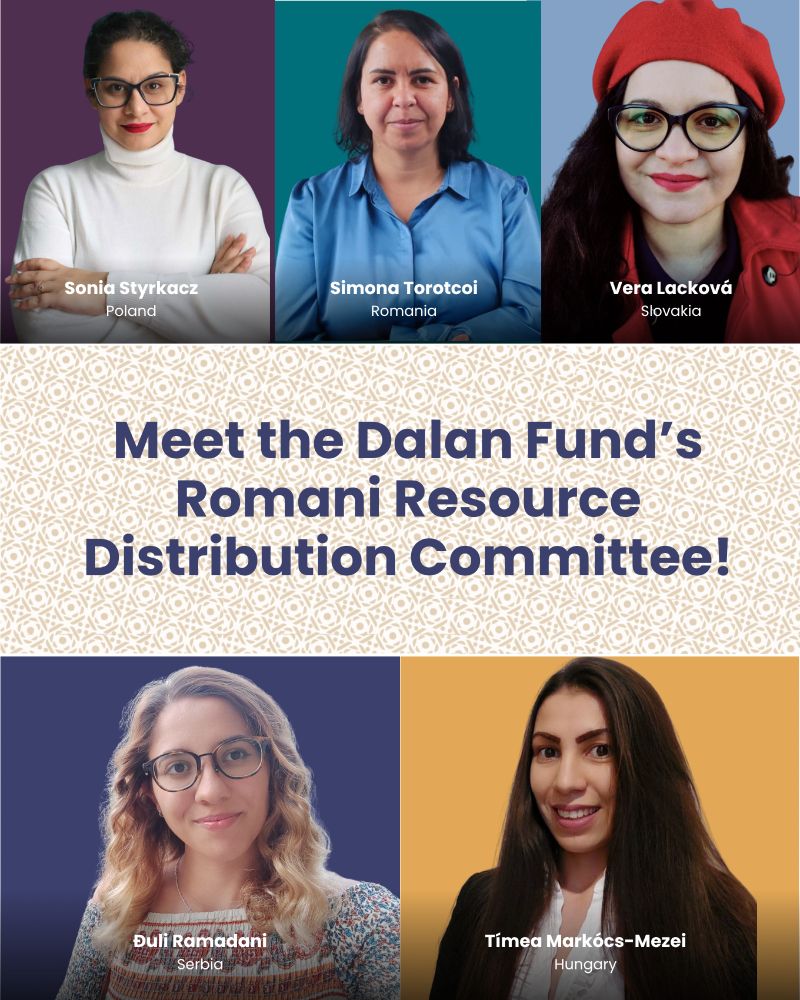
Five portraits of Romani women are arranged around a central patterned panel with the text: “Meet the Dalan Fund’s Romani Resource Distribution Committee!” Top row, from left to right: Sonia Styrkacz from Poland, wearing a white turtleneck and black glasses, smiling slightly, in front of a deep purple background. Simona Torotcoi from Romania, with short dark hair and a blue shirt, facing the camera seriously, in front of a teal background. Vera Lacková from Slovakia, wearing a red beret, red coat, and glasses, smiling warmly in front of a pale blue background. Middle of the image: a horizontal banner with a cream and beige geometric Kurak pattern and bold blue text that reads: “Meet the Dalan Fund’s Romani Resource Distribution Committee!” Bottom row, from left to right: Đuli Ramadani from Serbia, wearing a patterned blouse and round glasses, with long wavy hair, smiling in front of a dark blue background. Tímea Markócs-Mezei from Hungary, wearing a white shirt, long straight hair, and smiling in front of a mustard yellow background.
🧶 Meet our Romani Resource Distribution Committee!
Composed of 5 Romani women activists from Hungary, Poland, Romania, Slovakia and Serbia, the RDC actively shapes funding decisions and brings deep regional expertise to guide our resourcing for intersectional Romani organising.
🫴🏼 dub.sh/romani-rdc
25.06.2025 13:43 — 👍 1 🔁 0 💬 1 📌 0
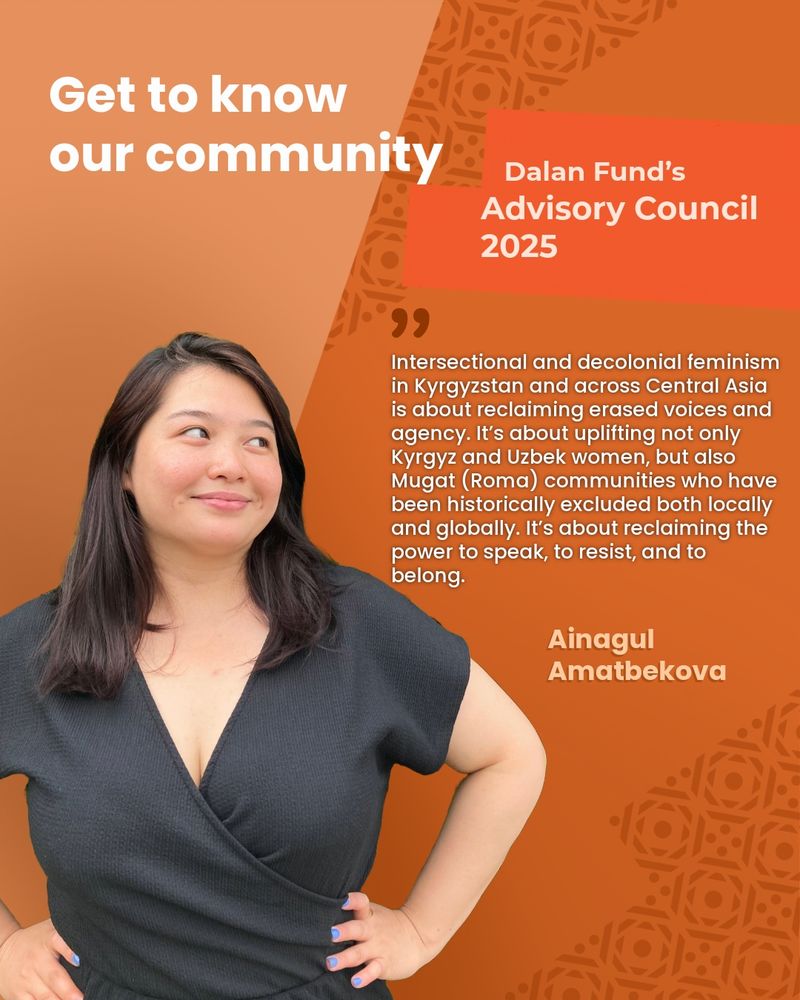
Portrait graphic introducing a member of the Dalan Fund’s Advisory Council 2025. The background features a warm gradient of orange with a subtle traditional pattern on the right side. At the top left, bold white text reads: “Get to know our community.” On the upper right, inside a red-orange box with dynamic angles, white and light orange text reads: “Dalan Fund’s Advisory Council 2025.” In the center-right, a quote in white text reads: “Intersectional and decolonial feminism in Kyrgyzstan and across Central Asia is about reclaiming erased voices and agency. It’s about uplifting not only Kyrgyz and Uzbek women, but also Mugat (Roma) communities who have been historically excluded both locally and globally. It’s about reclaiming the power to speak, to resist, and to belong.” The quote is attributed in bold light orange text to: “Ainagul Amatbekova.” On the left side of the image, there is a photo of Ainagul, a woman with long, straight, dark brown hair. She is wearing a black wrap-style dress and is standing with both hands on her hips. She is smiling softly and looking upward to the right, toward the text. Her nails are painted blue.
🧶 We’re thrilled to introduce 𝐀𝐢𝐧𝐚𝐠𝐮𝐥 𝐀𝐦𝐚𝐭𝐛𝐞𝐤𝐨𝐯𝐚, a civil society organiser and intersectional feminist activist from southern Kyrgyzstan, bringing critical Central Asian 𝐢𝐧𝐭𝐞𝐫𝐬𝐞𝐜𝐭𝐢𝐨𝐧𝐚𝐥 𝐚𝐧𝐝 𝐝𝐞𝐜𝐨𝐥𝐨𝐧𝐢𝐚𝐥 𝐩𝐞𝐫𝐬𝐩𝐞𝐜𝐭𝐢𝐯𝐞𝐬 to the Dalan Fund's resource distribution practices. ▶▶▶ dub.sh/meet-ainagul
24.06.2025 12:13 — 👍 0 🔁 0 💬 0 📌 0
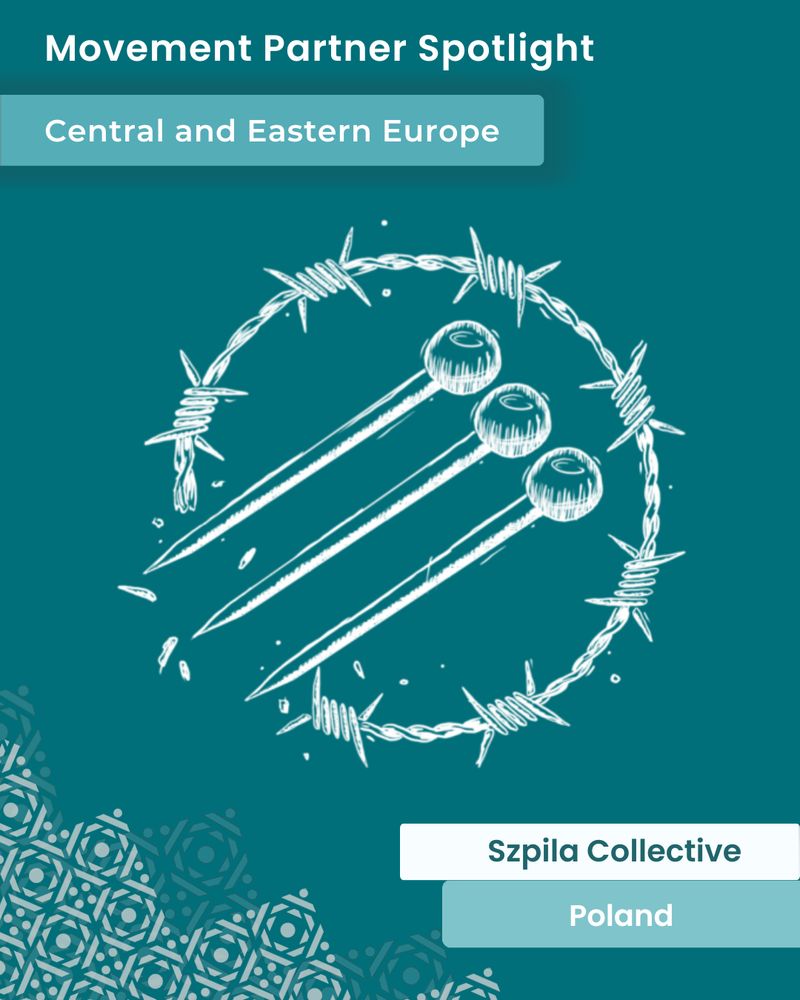
Teal background image featuring a white sketch of three sharp pins piercing through a circular barbed wire frame, with scattered shards around them. At the top, white bold text reads: “Movement Partner Spotlight.” Below it, a light blue label says: “Central and Eastern Europe.” Near the bottom, two overlapping labels display the group name and location — “Szpila Collective” in white on a teal background, and “Poland” in white on a light blue background. Decorative traditional-style Kurak patterns in white appear in the lower left corner.
Meet Szpila Collective, guided by “You will never walk alone.” Since 2000, they’ve supported activists in Poland and wider region with free legal aid, mental health support, 24/7 hotlines, workshops, advocacy and more — resisting repression through radical solidarity. 🔗 patronite.pl/szpila
17.06.2025 11:50 — 👍 0 🔁 0 💬 0 📌 0
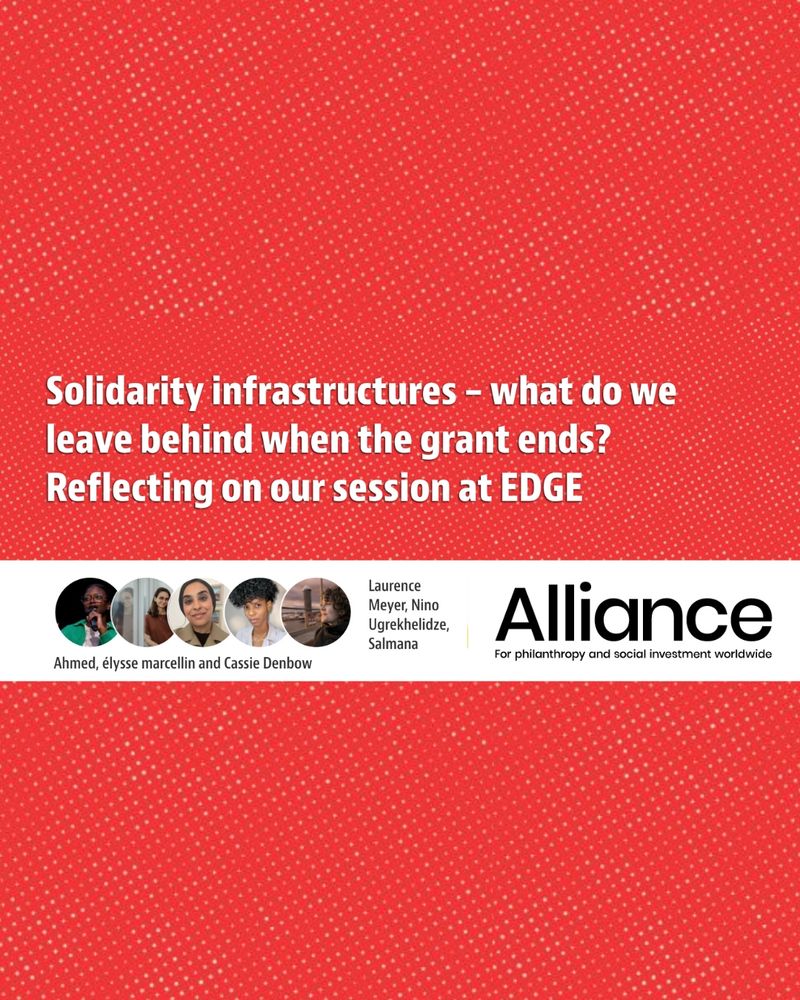
Red background with a subtle white dotted pattern. In the center, text reads: "Solidarity infrastructures – what do we leave behind when the grant ends? Reflecting on our session at EDGE." Below the main text is a horizontal white banner. On the left side of the banner are five small circular portraits of people. Close to the portraits, their names are written: Laurence Meyer, Nino Ugrekhelidze, Salmana Ahmed, élysse marcellin and Cassie Denbow. On the far right of the banner is the logo of Alliance, with the words: "For philanthropy and social investment worldwide."
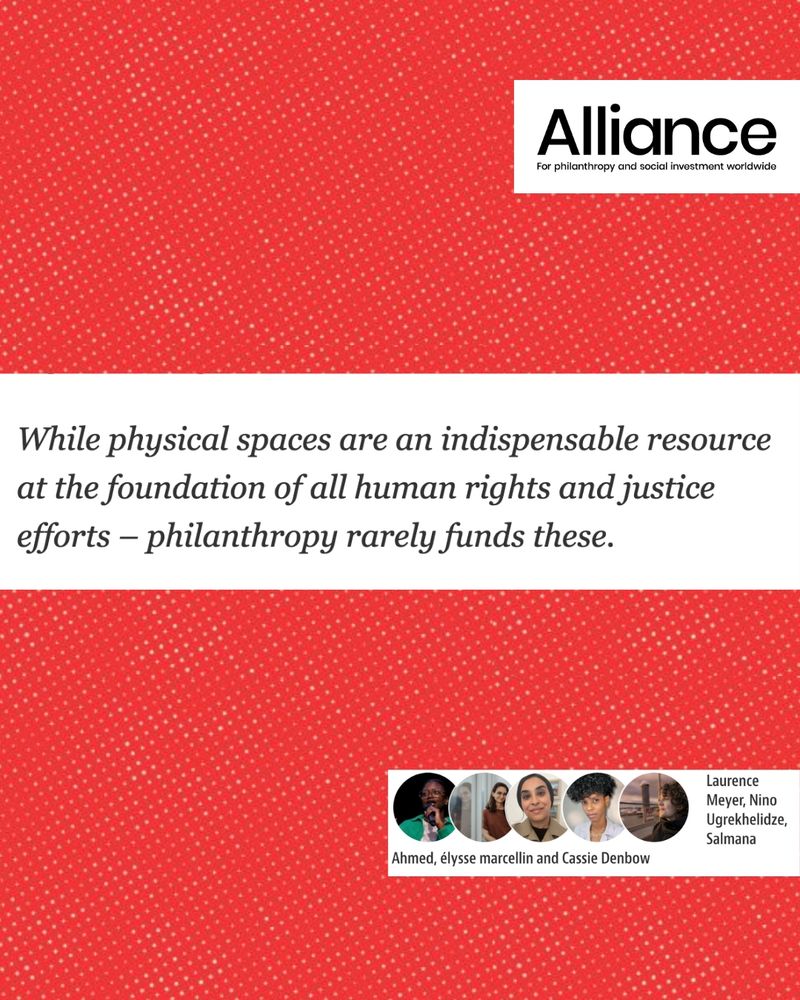
Red background with a subtle white dotted pattern. In the upper right corner, there is the Alliance logo with the words: "For philanthropy and social investment worldwide." In the center of the image, a white box contains the following black italic text: "While physical spaces are an indispensable resource at the foundation of all human rights and justice efforts – philanthropy rarely funds these." At the bottom of the image is a horizontal white banner. On the left side of the banner are five small circular portraits of people. Close to the portraits, their names are written: Laurence Meyer, Nino Ugrekhelidze, Salmana Ahmed, élysse marcellin and Cassie Denbow.
![Red background with a subtle white dotted pattern. In the upper right corner, there is the Alliance logo with the words: "For philanthropy and social investment worldwide." In the center of the image, a white box contains black text that reads: "[the solidarity infrastructures] collective understands its core role as building solidarity infrastructures. This means preparing for the worst-case scenarios – when moving money is close to impossible, when organisations are forced to wind down, when people need to flee countries, or when people are sick or burnt-out etc. – while also building to enable and sustain liberatory futures." At the bottom of the image is a horizontal white banner. On the left side of the banner are five small circular portraits of people. Close to the portraits, their names are written: Laurence Meyer, Nino Ugrekhelidze, Salmana Ahmed, élysse marcellin and Cassie Denbow.](https://cdn.bsky.app/img/feed_thumbnail/plain/did:plc:o3ltfa26svgbxrzlhqckap4g/bafkreihhgr6vpth4urow4k5fudhbtuo23vwlmxkhb4xshimcczwihuwjeu@jpeg)
Red background with a subtle white dotted pattern. In the upper right corner, there is the Alliance logo with the words: "For philanthropy and social investment worldwide." In the center of the image, a white box contains black text that reads: "[the solidarity infrastructures] collective understands its core role as building solidarity infrastructures. This means preparing for the worst-case scenarios – when moving money is close to impossible, when organisations are forced to wind down, when people need to flee countries, or when people are sick or burnt-out etc. – while also building to enable and sustain liberatory futures." At the bottom of the image is a horizontal white banner. On the left side of the banner are five small circular portraits of people. Close to the portraits, their names are written: Laurence Meyer, Nino Ugrekhelidze, Salmana Ahmed, élysse marcellin and Cassie Denbow.
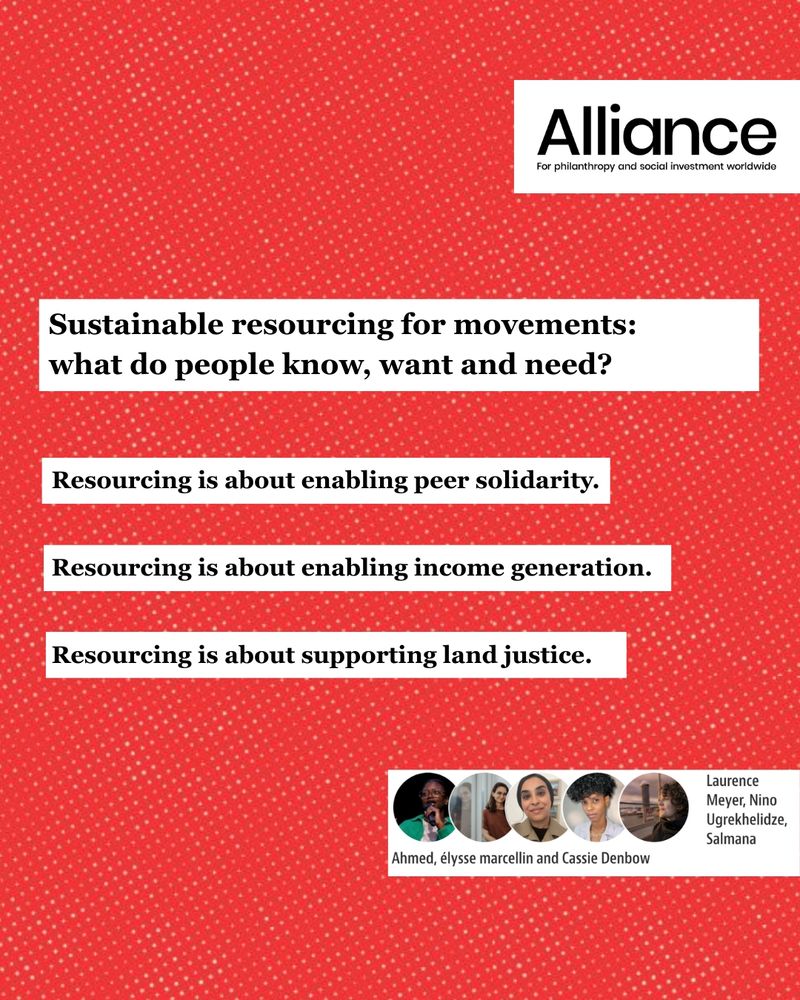
Red background with a subtle white dotted pattern. In the upper right corner, there is the Alliance logo with the words: "For philanthropy and social investment worldwide." In the center of the image, four separate white text boxes contain black text. The first and largest box reads: "Sustainable resourcing for movements: what do people know, want and need?" Below it are three smaller text boxes, each with one of the following statements: "Resourcing is about enabling peer solidarity.", "Resourcing is about enabling income generation.", "Resourcing is about supporting land justice." At the bottom of the image is a horizontal white banner. On the left side of the banner are five small circular portraits of people. Close to the portraits, their names are written: Laurence Meyer, Nino Ugrekhelidze, Salmana Ahmed, élysse marcellin and Cassie Denbow.
In Oct 2024, Weaving Liberation hosted the first Digital Liberation Retreat, sparking the Solidarity Infrastructures collective — co-owned spaces for shared futures.
At #EDGE2025, we asked: What do we leave behind when the grant ends?
Read more @alliance.magazine 🫴🏼
🔗 dub.sh/solidarity-E...
16.06.2025 08:00 — 👍 0 🔁 0 💬 0 📌 0
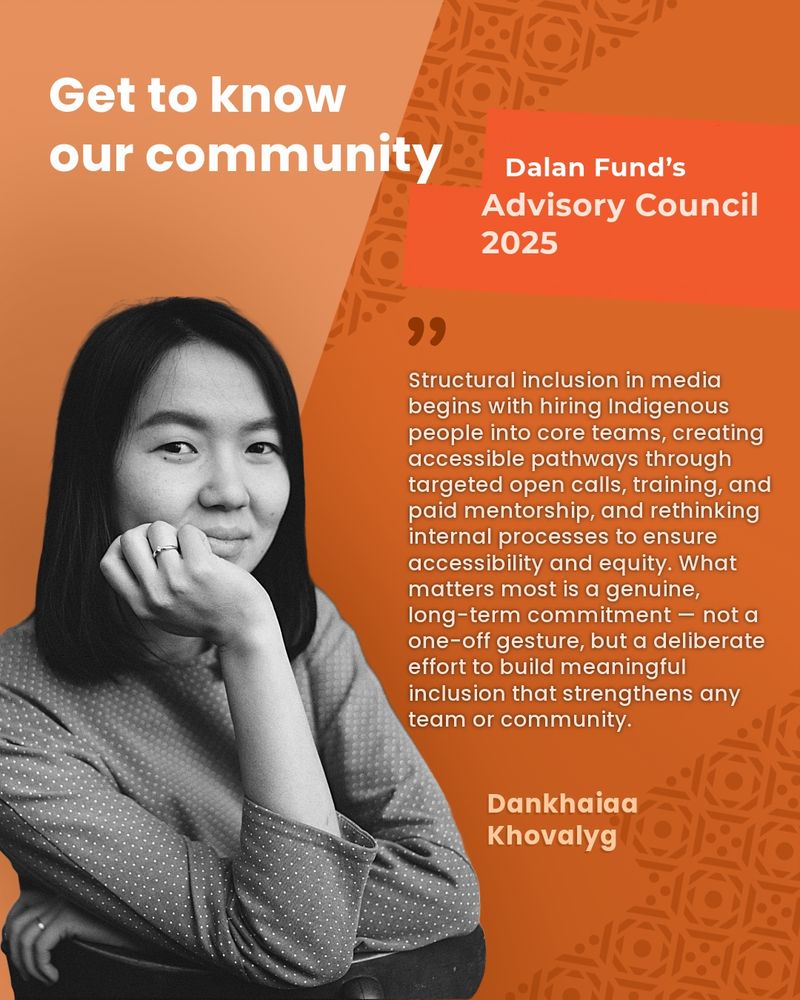
Portrait-style graphic introducing a member of the Dalan Fund’s Advisory Council 2025. The design features a warm orange and rust background with traditional Central Asian pattern accents. On the left side is a grayscale photo of Dankhaiaa Khovalyg — a person with long, straight dark hair and a thoughtful expression, resting their chin on their hand. They wear a patterned long-sleeve shirt and a ring on their finger. Large white text at the top reads:
“Get to know our community”. In a bold red block, it says: “Dalan Fund’s Advisory Council 2025” To the right of the photo is a quotation in white text: "Structural inclusion in media begins with hiring Indigenous people into core teams, creating accessible pathways through targeted open calls, training, and paid mentorship, and rethinking internal processes to ensure accessibility and equity. What matters most is a genuine, long-term commitment — not a one-off gesture, but a deliberate effort to build meaningful inclusion that strengthens any team or community.” Dankhaiaa’s name appears in bold light-orange text at the bottom right:
Dankhaiaa Khovalyg.
Meet 𝐃𝐚𝐧𝐤𝐡𝐚𝐢𝐚𝐚 𝐊𝐡𝐨𝐯𝐚𝐥𝐲𝐠 — journalist, decolonial activist from Tyva, and creator of “говорит республика” ("republic speaking"). A member of Dalan Fund’s 2025 Advisory Council, she centers Indigenous voices through media and activism.
🔗 dub.sh/meet-dankhaiaa
23.05.2025 09:27 — 👍 0 🔁 0 💬 0 📌 0
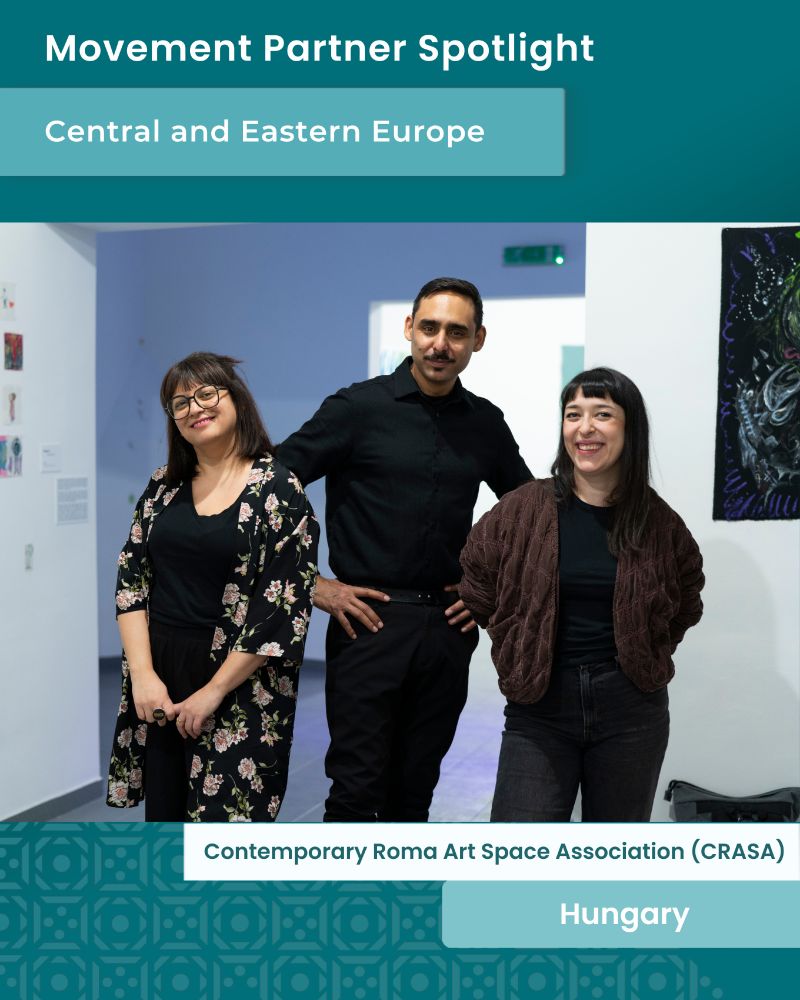
Three people stand side by side in a contemporary art gallery space, smiling warmly at the camera. On the left is a woman with long dark hair, wearing glasses, a black top, and a black floral-patterned kimono-style jacket. In the center is a man with short dark hair and a mustache, wearing a black shirt tucked into black trousers, with one hand resting on his hip. On the right is a woman with long dark hair and bangs, wearing a dark brown textured jacket and dark jeans. Behind them, the gallery walls display colorful artwork and informational posters. The image is framed with a teal graphic design overlay. At the top, bold text reads “Movement Partner Spotlight” and “Central and Eastern Europe.” At the bottom, a text box identifies the group as “Contemporary Roma Art Space Association (CRASA)” and notes their location as “Hungary.”
Meet our movement partners the Contemporary Roma Art Space Association (CRASA), also known as the informal Bura Kollektiva — a collective of Roma artists and community organizers reclaiming space, visibility, and narrative power in Hungary.
More: linktr.ee/buragaleria
22.05.2025 12:51 — 👍 1 🔁 0 💬 0 📌 0
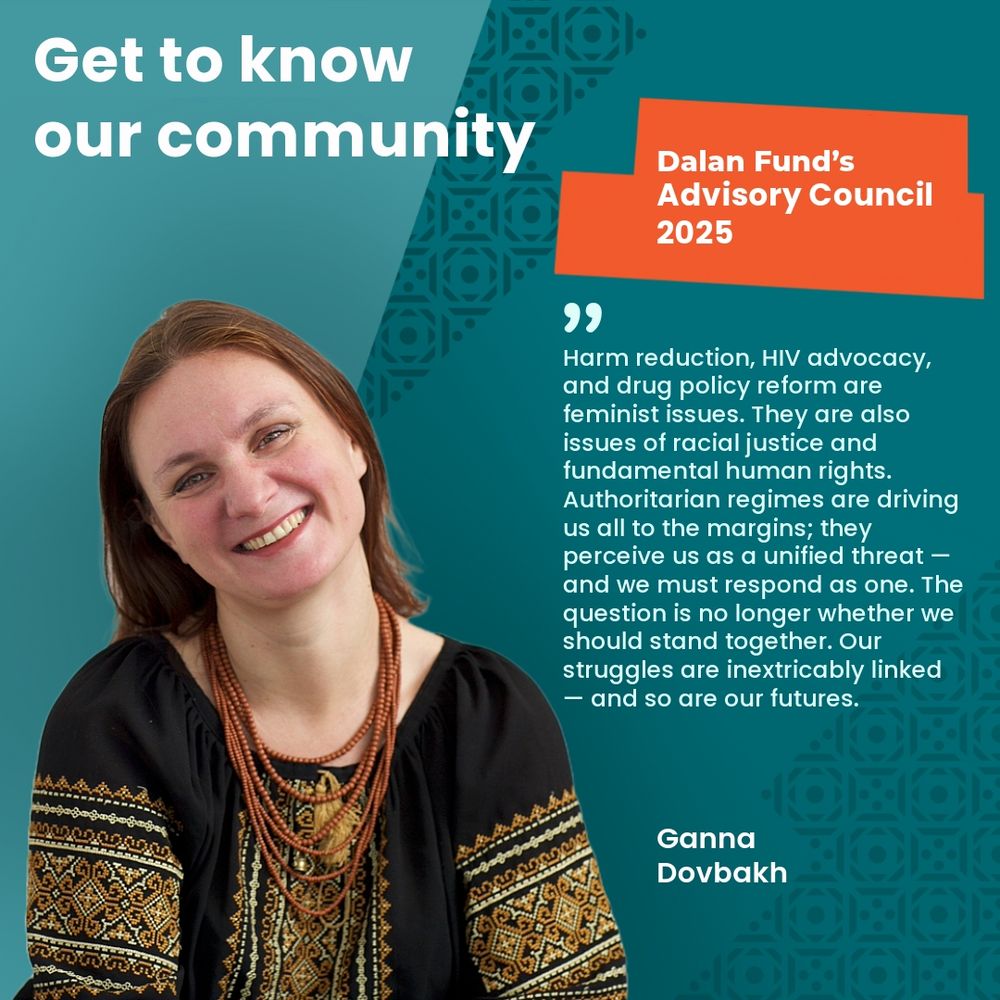
Portrait of Ganna Dovbakh, member of the Dalan Fund’s Advisory Council 2025, smiling in a traditional embroidered blouse and layered orange necklace. The background is teal with a subtle geometric pattern resembling traditional Central Asian or Caucasus motifs in the top right and bottom right corners. At the top left, large white text reads: “Get to know our community.” On the top right, there is an orange banner with white text that reads: “Dalan Fund’s Advisory Council 2025.” Centered on the right side of the image is a quote in white text with a teal quotation mark at the top. The quote reads: “Harm reduction, HIV advocacy, and drug policy reform are feminist issues. They are also issues of racial justice and fundamental human rights. Authoritarian regimes are driving us all to the margins; they perceive us as a unified threat — and we must respond as one. The question is no longer whether we should stand together. Our struggles are inextricably linked — and so are our futures.”
Meet Ganna Dovbakh — feminist activist from Ukraine, and Dalan Fund's 2025 Advisory Council member.
With deep expertise in HIV, harm reduction & community rights, Ganna is shaping justice-driven futures for Central and Eastern Europe, Caucasus, Central and North Asia.
🔗 More: dub.sh/meet-ganna
19.05.2025 10:14 — 👍 0 🔁 1 💬 0 📌 0
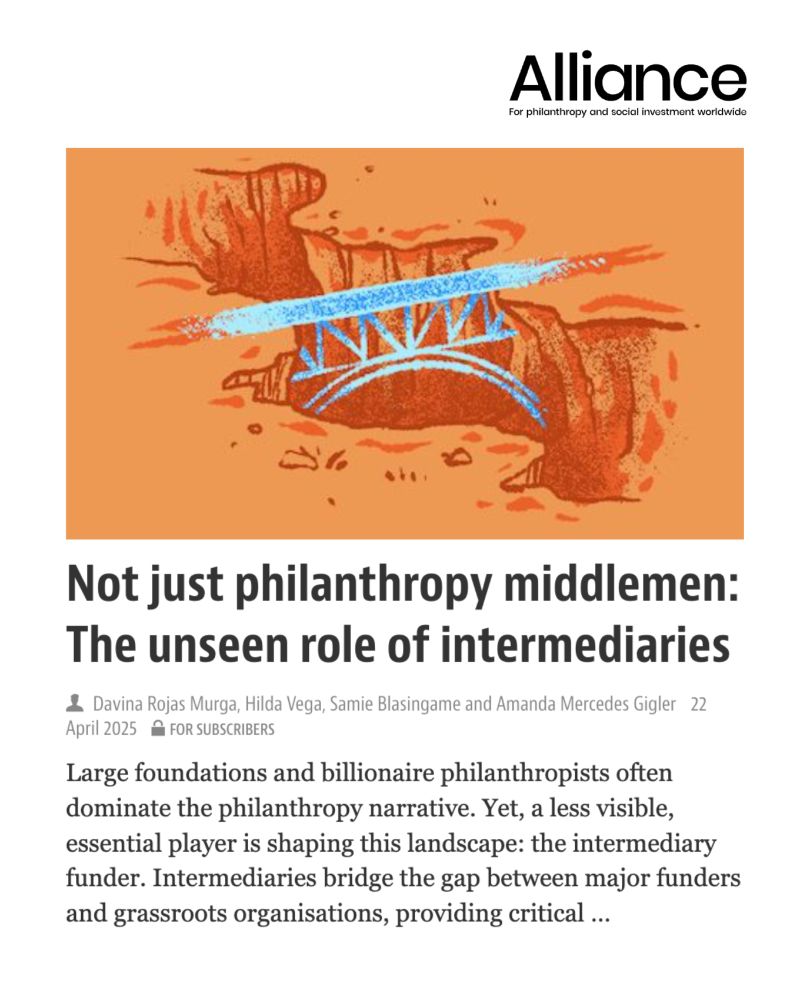
Screenshot of an Alliance Magazine article titled “Not just philanthropy middlemen: The unseen role of intermediaries” by Davina Rojas Murga, Hilda Vega, Samie Blasingame, and Amanda Mercedes Gigler, dated 22 April 2025. The subheading reads: “Large foundations and billionaire philanthropists often dominate the philanthropy narrative. Yet, a less visible, essential player is shaping this landscape: the intermediary funder.
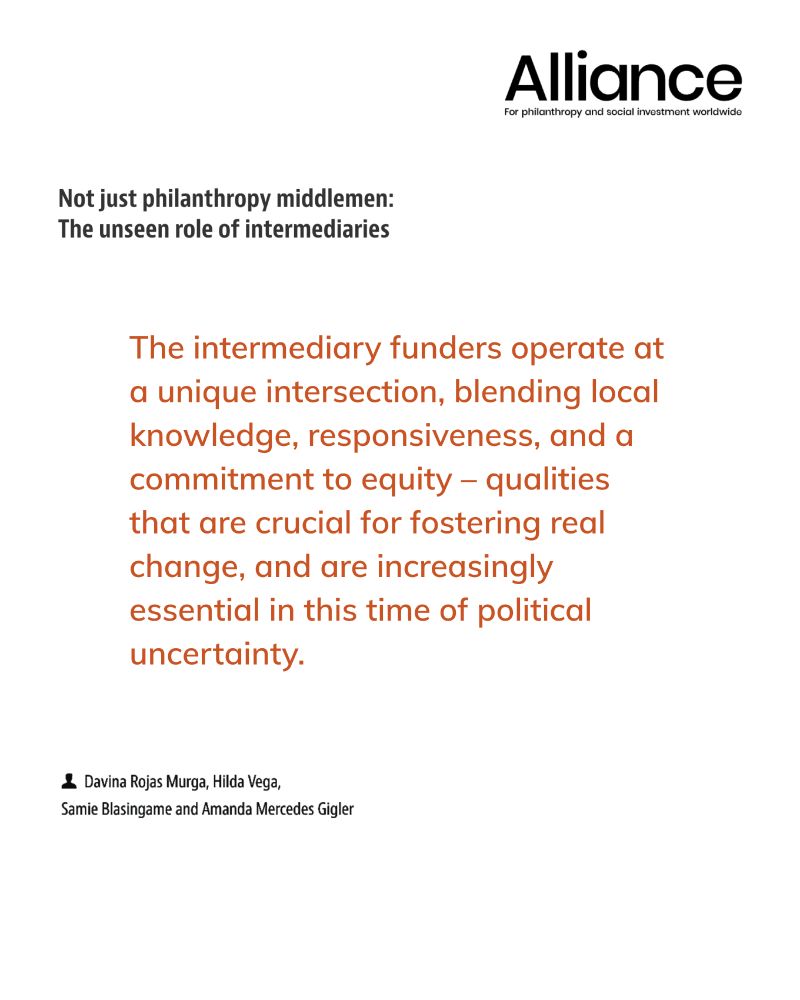
Graphic from Alliance Magazine on a white background. At the top right is the black Alliance logo with the tagline “For philanthropy and social investment worldwide.” Centered in large orange text is a quote: “The intermediary funders operate at a unique intersection, blending local knowledge, responsiveness, and a commitment to equity – qualities that are crucial for fostering real change, and are increasingly essential in this time of political uncertainty.” Author names appear below in small black text: Davina Rojas Murga, Hilda Vega, Samie Blasingame, and Amanda Mercedes Gigler.
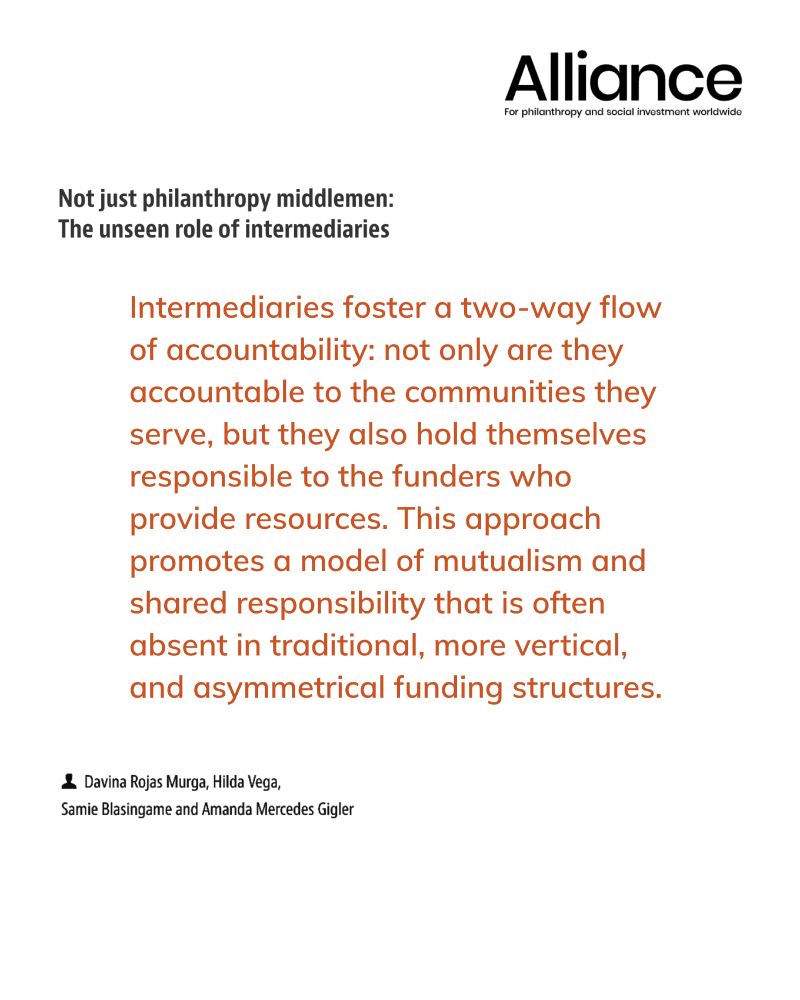
Graphic from Alliance Magazine on a white background. At the top right is the black Alliance logo with the tagline “For philanthropy and social investment worldwide.” The title reads: Not just philanthropy middlemen: The unseen role of intermediaries. Centered in large orange text is the quote: Intermediares foster a two-way flow of accountability: not only are they accountable to the communities they serve, but they also hold themselves responsible to the funders who provide resources. This approach promotes a model of mutualism and shared responsibility that is often absent in traditional, more vertical, and asymmetrical funding structures." Author names appear below in small black text: Davina Rojas Murga, Hilda Vega, Samie Blasingame, and Amanda Mercedes Gigler.
We’re thrilled to be mentioned in Alliance Magazine's latest premium article, alongside other inspiring funds and resource distribution organisations working to transform the future of philanthropy.
Explore more at www.alliancemagazine.org
01.05.2025 08:17 — 👍 1 🔁 0 💬 0 📌 0

"Dark blue rectangular graphic with symmetrical white pattern running vertically along both the left and right edges, inspired by traditional textile designs from Central and Eastern Europe, the Caucasus, Central and North Asia. Centered on the right side of the image is the bold orange title in large capital letters: “SHIELD FUND”. Below it, in smaller light gray text, it reads: “Dalan Fund’s Crisis Response to the Impact of the US Funding Cuts on Movement-based Organizations in Central and Eastern Europe, Caucasus, Central and North Asia (CEECCNA)”."
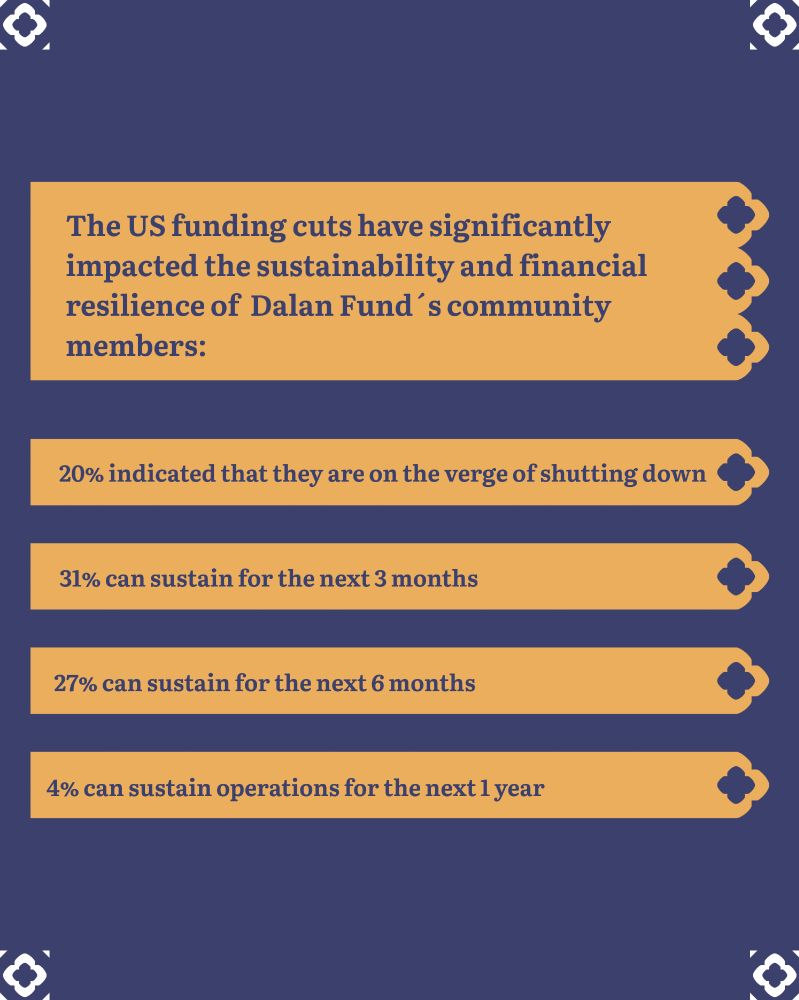
A dark blue rectangular graphic with four small white corner accents resembling traditional Central and Eastern European, Caucasian, Central and North Asian patterns. At the top, there's a large orange text box with decorative arrow-shaped ends on the right. It contains the main message in blue text: "The US funding cuts have significantly impacted the sustainability and financial resilience of Dalan Fund’s community members:". Below, there are four smaller horizontal orange bars with the same decorative ends and blue text inside, listing statistical impacts: 20% indicated that they are on the verge of shutting down. 31% can sustain for the next 3 months. 27% can sustain for the next 6 months. 4% can sustain operations for the next 1 year.

A dark blue background with small white corner elements inspired by traditional patterns from Central and Eastern Europe, the Caucasus, Central and North Asia. In the center is a square orange box with a decorative notch at the bottom and slightly rounded corners. Inside the box, centered text reads: For 44% of our grantee partners, Dalan Fund is the only remaining funder at the moment. The words “Dalan Fund” and “is the only remaining funder” are highlighted in bold to emphasize the urgency and importance of the message.
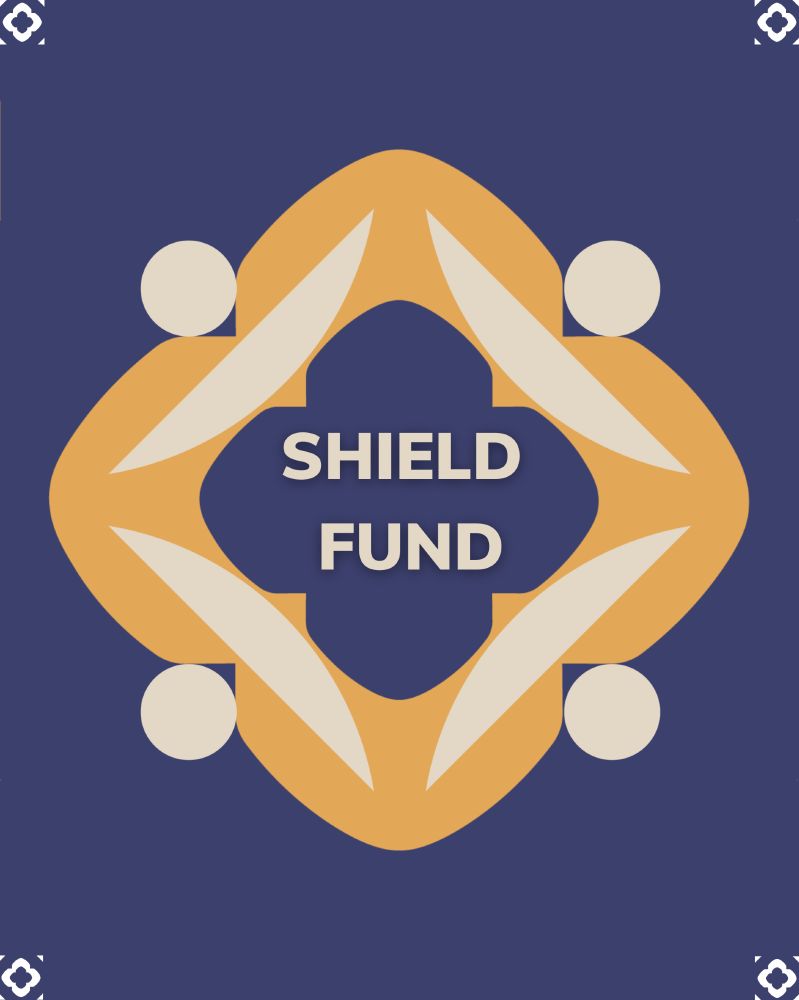
🛡️ The US funding freeze — alongside other shifts in the human rights funding landscape - have left many movement-based organisations in #CEECCNA fighting for their survival. In response to this crisis, we have created the Shield Fund, a participatory crisis response mechanism 🫴🏼 dub.sh/shield-fund
29.04.2025 11:54 — 👍 2 🔁 0 💬 0 📌 0
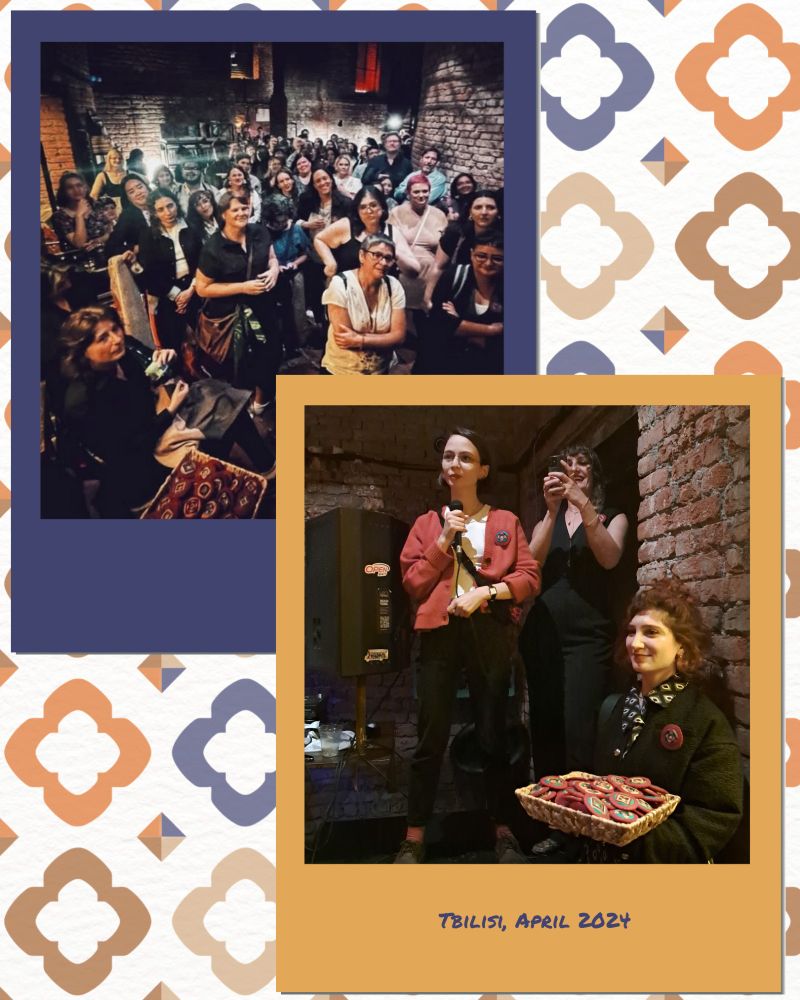
Two photographs placed on a patterned background with traditional geometric motifs resembling Kurak in terracotta, beige, and indigo. The top photo, framed in indigo, shows a large group of people gathered in a warmly lit, rustic brick venue. They stand closely together, smiling and attentively listening to something out of frame. The bottom photo, framed in mustard yellow, captures a moment during an event: a person with semi-long brown hair, holding a microphone, stands in front of a brick wall and speaks, while another person behind them takes photos on a phone. A third person, red-haired, dressed in a jacket and dress, smiles while holding a basket filled with round embroidered items featuring Kurak patterns. A handwritten caption at the bottom reads: 'Tbilisi, April 2024.
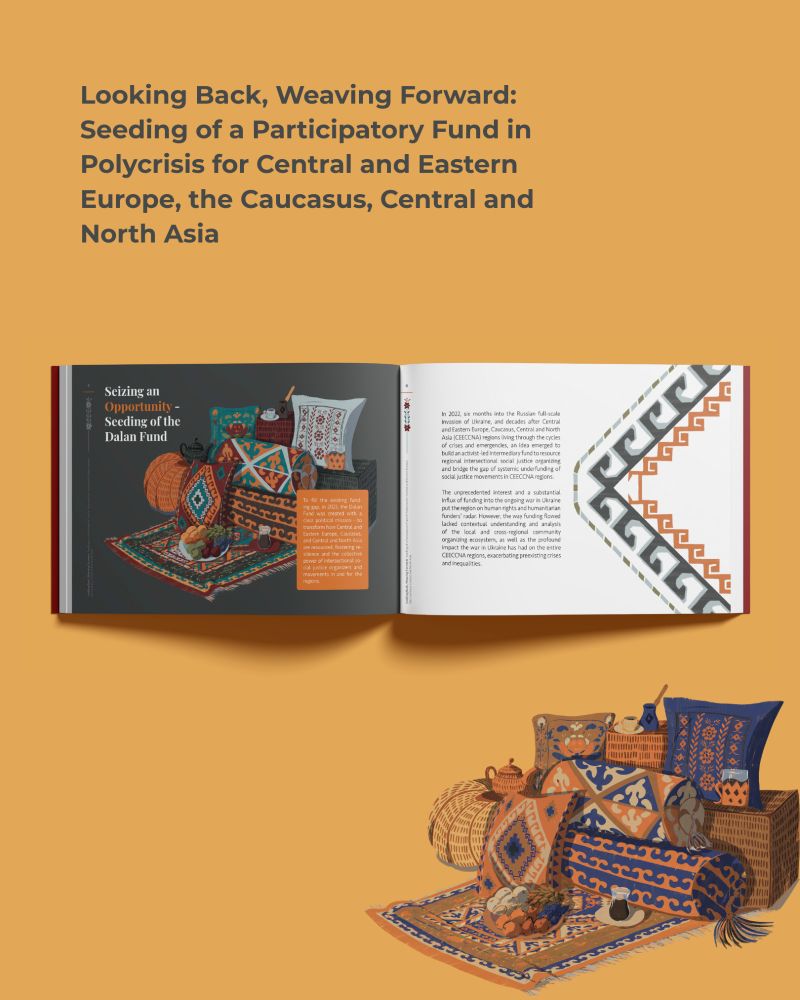
A graphic layout featuring a publication titled 'Looking Back, Weaving Forward: Seeding of a Participatory Fund in Polycrisis for Central and Eastern Europe, the Caucasus, Central and North Asia.' The top of the image displays the title in bold dark orange text on a mustard yellow background. Below, an open book shows an illustrated spread: the left page features vibrant drawings of a traditional setup with mutaka pillows, woven baskets, pottery, and textiles arranged on an ornate rug, evoking the cozy and communal atmosphere of a chaikhana (tea house). A caption on the page reads: 'Seizing an Opportunity – Seeding of the Dalan Fund.' The right page contains text contextualizing the fund’s launch during crisis, with a decorative border of traditional regional patterns. Below the book, a three-dimensional illustration of the same chaikhana-inspired setup—with mutaka pillows, tea, fruit, and textiles—extends the theme of warmth, culture, and hospitality.
One year ago today, we officially launched Dalan Fund in Tbilisi at the Ariadne/HRFN conferences — amidst the rise of year-long civic resistance against Georgia’s authoritarian government.
Explore our journey: dub.sh/seeding-report
#CEECCNA
24.04.2025 20:52 — 👍 4 🔁 0 💬 0 📌 1
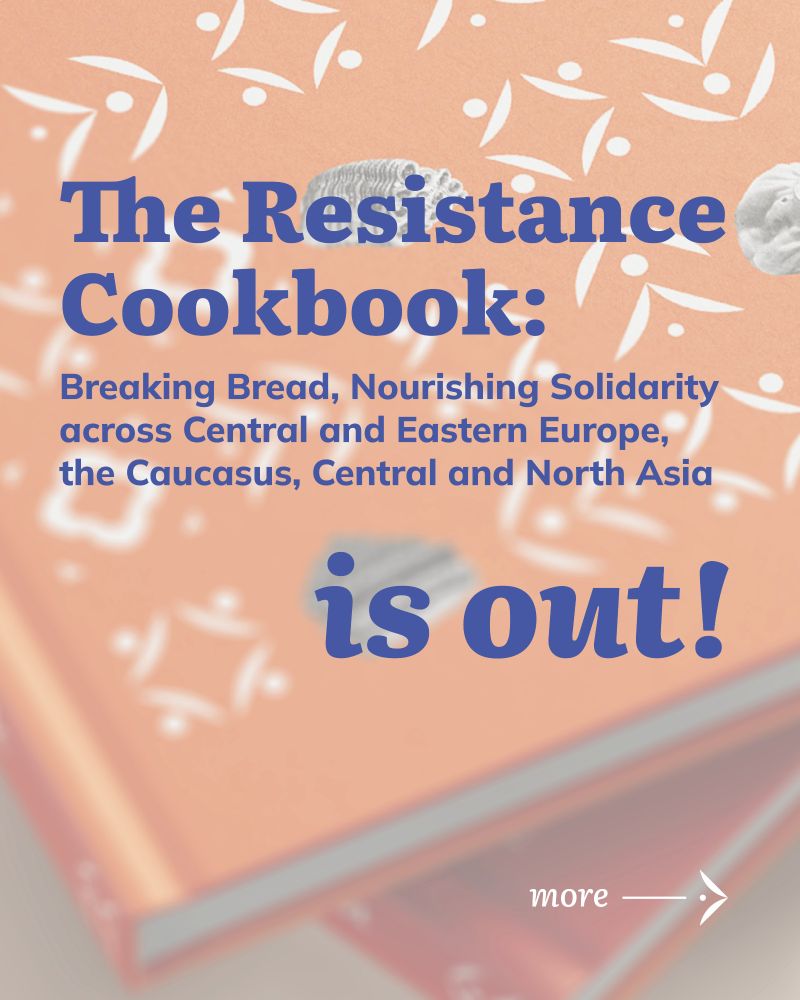
A promotional graphic announcing the launch of The Resistance Cookbook. The background features a close-up of two orange hardcover books with white folk-style patterns resembling embroidered or woven textile designs. The patterns include dots, leaves, and abstract floral shapes. The text in the foreground reads: “The Resistance Cookbook: Breaking Bread, Nourishing Solidarity across Central and Eastern Europe, the Caucasus, Central and North Asia is out!” in bold, dark blue font. In the lower right corner, smaller white text reads “more →” with an arrow pointing right, suggesting a clickable link or further information. The image conveys a sense of celebration and cultural richness, blending visual motifs of tradition and activism.
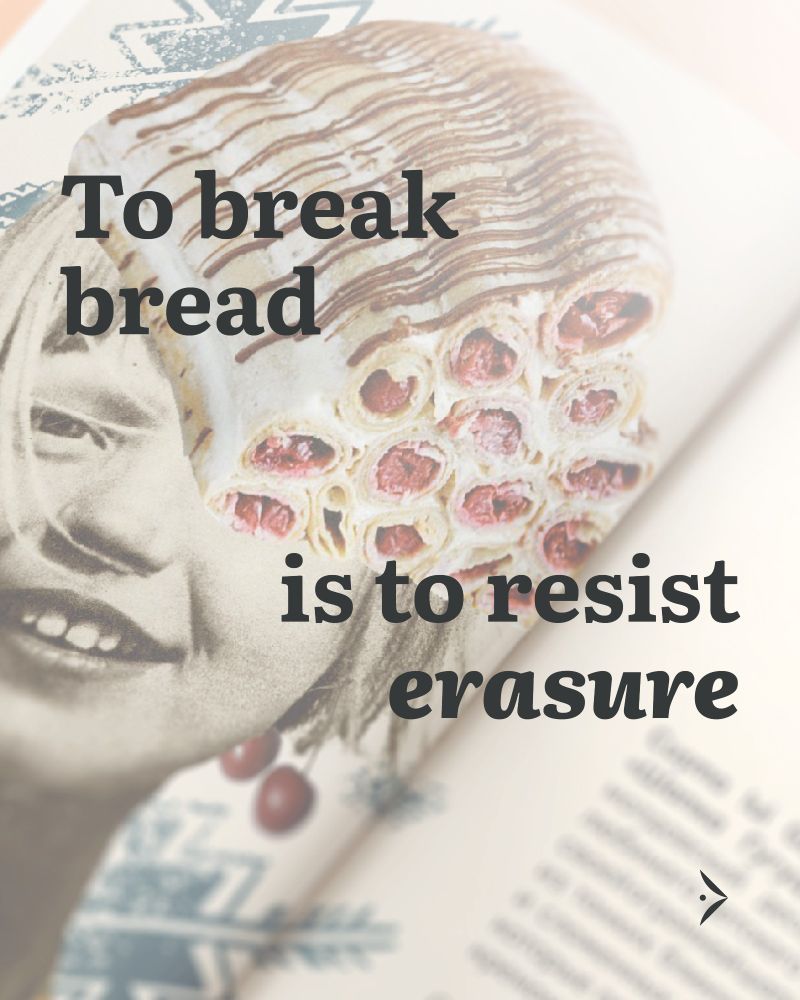
A stylized page from The Resistance Cookbook, blending archival photography and culinary imagery. The left side features a black-and-white photo of a smiling child, with the upper portion of their head replaced by a stack of rolled pancakes filled with red berries and drizzled with syrup. The background shows a page of the cookbook with blue-and-red folkloric patterns and cherry motifs. Bold black text across the image reads: “To break bread is to resist erasure,” with the word “erasure” emphasized in italic font. A small arrow icon in the lower right hints at further pages in the carousel. The composition evokes memory, culture, and resilience through food and storytelling.
🥟 The Resistance Cookbook is here!
We’re beyond thrilled to share this collective, community-driven creation — a tapestry of recipes, stories and strategies from #CEECCNA, where food is care, resilience and resistance.
🔗 Cook, share, enjoy 🫴🏼 dub.sh/cookbook
22.04.2025 14:56 — 👍 1 🔁 0 💬 0 📌 0
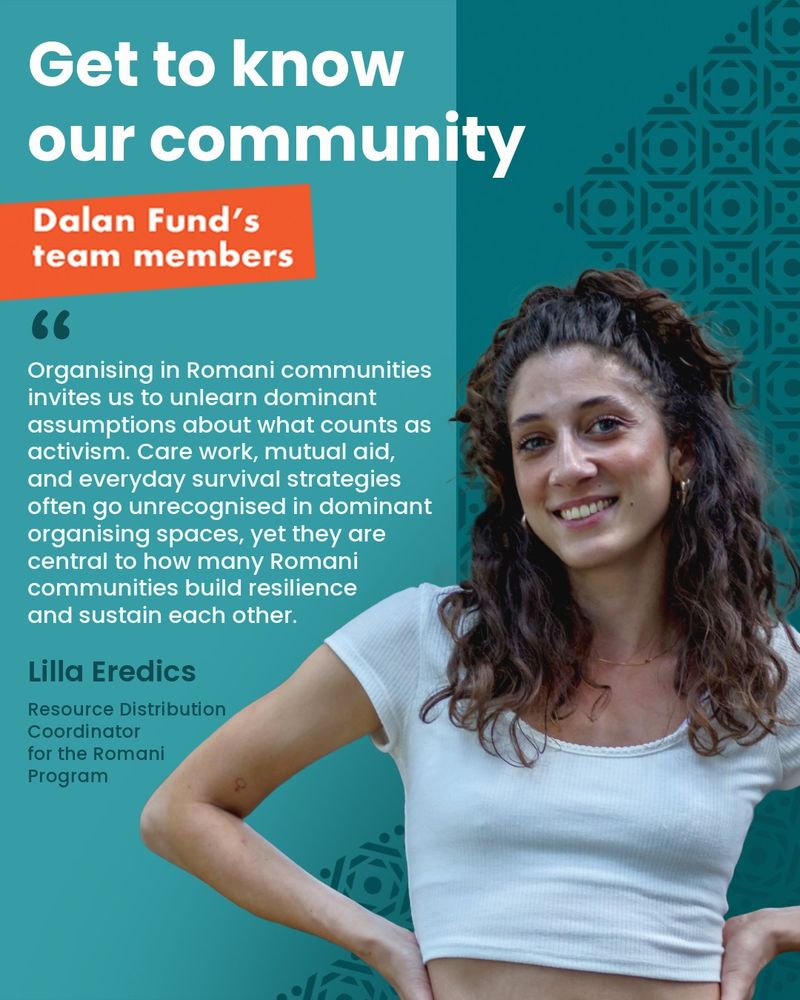
This image features Lilla Eredics, Resource Distribution Coordinator for the Romani Program at Dalan Fund. She is smiling, with long curly dark hair, wearing a white cropped top, and standing with both hands resting on her hips. The background is teal with a geometric pattern inspired by traditional patchwork pattern Kurak. Text on the image introduces her as part of the Dalan Fund’s team and features the following quote: “Organising in Romani communities invites us to unlearn dominant assumptions about what counts as activism. Care work, mutual aid, and everyday survival strategies often go unrecognised in dominant organising spaces, yet they are central to how many Romani communities build resilience and sustain each other.
🧶 We're thrilled to introduce 𝐋𝐢𝐥𝐥𝐚 𝐄𝐫𝐞𝐝𝐢𝐜𝐬, our 𝐑𝐞𝐬𝐨𝐮𝐫𝐜𝐞 𝐃𝐢𝐬𝐭𝐫𝐢𝐛𝐮𝐭𝐢𝐨𝐧 𝐂𝐨𝐨𝐫𝐝𝐢𝐧𝐚𝐭𝐨𝐫 𝐟𝐨𝐫 𝐭𝐡𝐞 𝐑𝐨𝐦𝐚𝐧𝐢 𝐏𝐫𝐨𝐠𝐫𝐚𝐦 and a community organiser and anthropologist specialising in the lived experiences of gendered and racially marginalised communities.
Meet Lilla 🫴🏼 dub.sh/meet-lilla
08.04.2025 16:27 — 👍 0 🔁 0 💬 0 📌 0
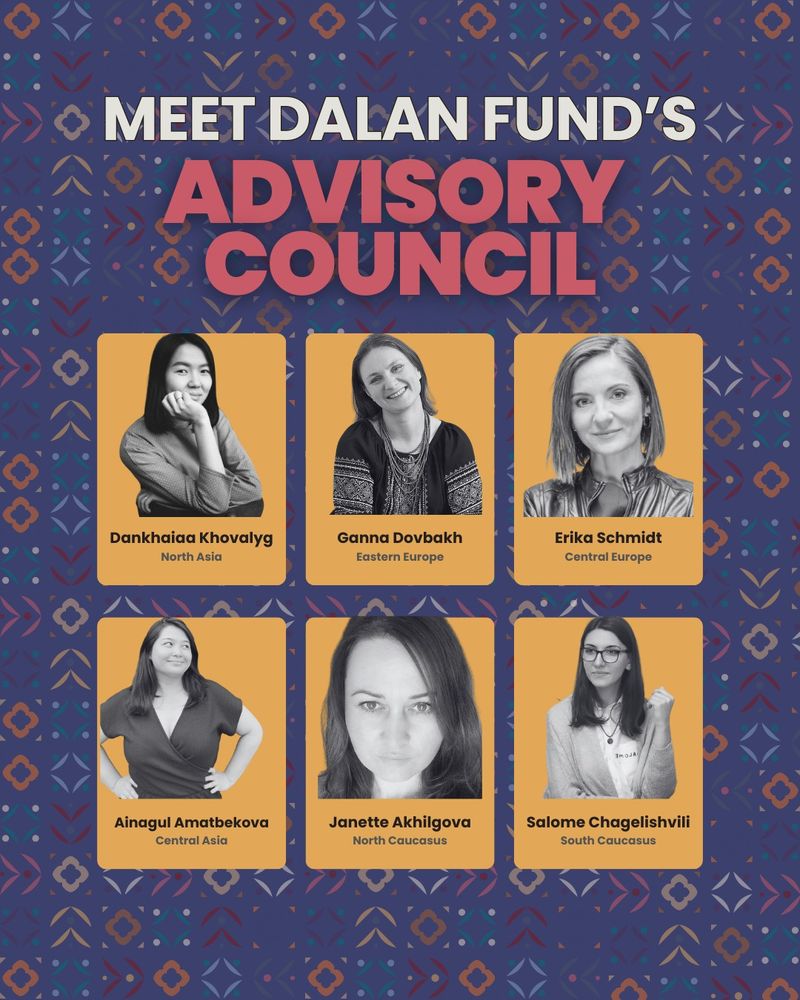
Graphic introducing the Dalan Fund’s Advisory Council, with bold white and pink text at the top reading “Meet Dalan Fund’s Advisory Council” on a dark blue background with a colorful traditional geometric pattern. Six black-and-white portraits of council members appear in mustard yellow rectangles with their names and regions: Dankhaiaa Khovalyg (North Asia), Ganna Dovbakh (Eastern Europe), Erika Schmidt (Central Europe), Ainagul Amatbekova (Central Asia), Janette Akhilgova (North Caucasus), and Salome Chagelishvili (South Caucasus).
🧶 Exciting news! In early 2025, Dalan Fund launched a new chapter — forming an Advisory Council that will accompany the Fund throughout the 2025–2026 Pilot Cycle.
Meet the members 🫴🏼 dub.sh/dalan-advisory
07.04.2025 13:02 — 👍 0 🔁 0 💬 0 📌 0
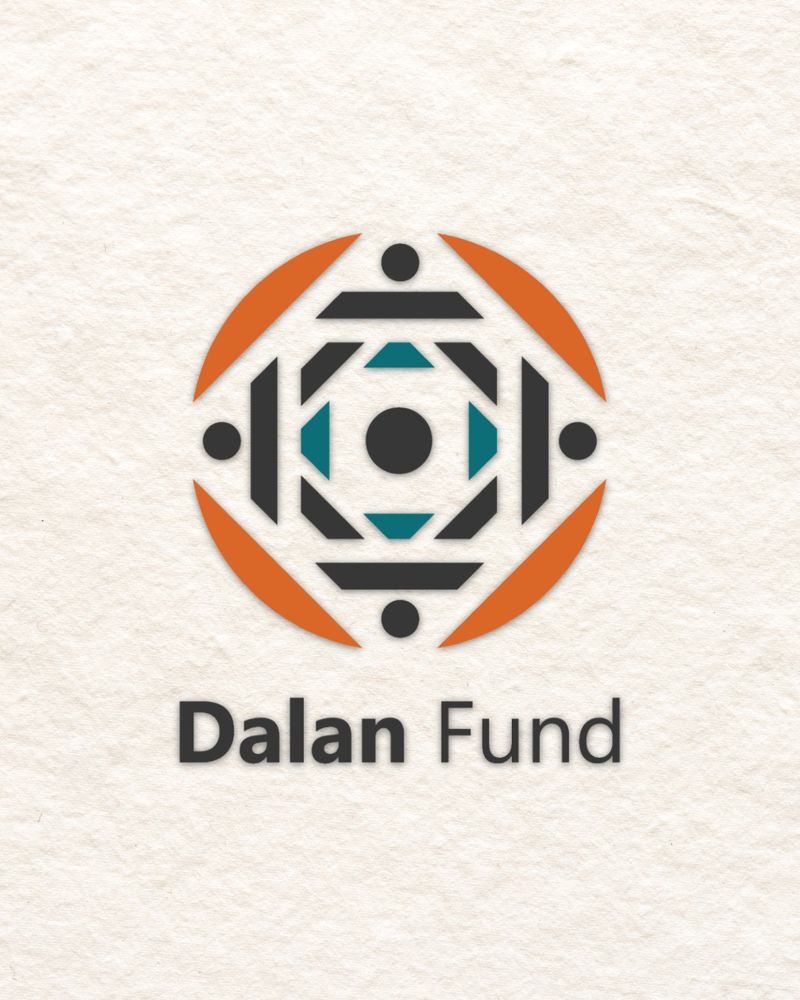
Logo of Dalan Fund on a textured beige background. The logo features a circular geometric design resembling a traditional textile pattern. It consists of orange curved elements forming a circle, black shapes suggesting human figures facing inward, and teal and black angular forms creating a symmetrical, woven-like motif. Below the symbol, the words “Dalan Fund” are written, with “Dalan” in bold black font.
Hello! We’re Dalan Fund — transforming how Central and Eastern Europe, the Caucasus, Central and North Asia (#CEECCNA) are resourced by centering resilience and the collective power of intersectional social justice movements.
Let’s reimagine solidarity together!
Learn more: www.dalan.fund
06.04.2025 18:33 — 👍 1 🔁 0 💬 0 📌 0
The Women Human Rights Defenders International Coalition (WHRD-IC) is a transnational, intersectional feminist coalition of women human rights defenders, feminists, trans and non-binary activists and organisations, and their allies.
We are a consortium of 15 leading European NGOs working to ensure #AWorldWhere we all have universal access to sexual and reproductive health and rights.
http://www.countdown2030europe.org
Working on & defending global health & universal human rights. Private account & views.
https://www.linkedin.com/in/katri-bertram-85025787
Consultant on gender, adolescence, SRHR, and philanthropy (www.genderequalitysolutions.com). Also a dog lover, skier, and fan of women's soccer, bball, and sane people.
Global #SRHR, working at the intersection of public policy, human rights, and imp sci. These days, all things #PPH.
Posts = own views
https://orcid.org/0000-0002-4925-869X
Health & human rights. Lawyer, independent consultant, former ED @HIVlegal. HIV, harm reduction & drug policy, COVID, 2SLGBTQ+, access to meds, SRHR, other health & human rights issues, #cdnpoli. Plus fantasy & SF. Halifax. #CanadaSky (he/him)😷 🏳️🌈🇨🇦
Midwife, maternal and newborn health researcher, educator. Committed to SRHR for all. Deputy Director Gender Equity, Diversity & Inclusion at the Burnet Institute.
Researcher and Activist: #SRHR, #Gender, and #YouthRights | Advocacy and Comms | Community Strategist | Storyteller | #EmpoweredSonOfTheSoil | Views=Mine
https://linktr.ee/steveougo
Women's Health, SRHR & Global Health Researcher | FemTech Advisor & Founder | Health Access & Equity Advocate 🇺🇦
Own views. She/her.
Bluesky account for the UK APPG on Global Sexual and Reproductive Health and Rights. Supported by UNFPA, IPPF and EPF
RTs for information, not endorsement.
This is not an official feed of the House of Commons or the House of Lords.
US grassroots org providing population education & advocating progressive action to improve health, human rights, & #environmental sustainability globally.🌲🫂🐿️
#FamilyPlanning #Biodiversity #SRHR #Aging @popconnectaction.bsky.social
populationconnection.org
European Parliamentary Forum for Sexual & Reproductive Rights | We're a network of Members of Parliament in #Europe and beyond, committed to advancing sexual & reproductive rights #SRHR . More at www.epfweb.org
Over 40 years of advancing policies that enable all people to realise the human right to the highest attainable level of health. Website: www.haiweb.org #globalhealth #healhAI #Diabetes #SRHR
A fund that supports civil society organisations (CSOs) who advocate for improved sexual and reproductive health and rights (SRHR) for all.
Learn more at https://amplifychange.org
Shares & follows ≠ endorsements
We are Europe’s largest feminist movement, supported by over 300 organizations and a vast network of volunteers throughout the EU fighting for safe and accessible abortion. 💸 https://cause.lundadonate.org/myvoicemychoice/legal-fight
FICS. Defending and Expanding #Civic Space.
https://www.fundersinitiativeforcivilsociety.org/
Transforming power relations and promoting peace by strengthening gender justice movements through our Partnership of women's rights organizations in the Global South.
🏳️🌈 ԼԳԲՏ+ իրավապաշտպան ՀԿ Հայաստանում
LGBT+ Human Rights Defender NGO in Armenia
https://linktr.ee/pinkarmenia
https://pinkarmenia.org
#ԼԳԲՏ #իրավապաշտպան #իրավունք #ՄարդուԻրավունքներ #LGBT #HumanRights #Armenia #pinkarmenia
Sustainable Development Organization (SDO) is uplifting people through education, health, water, employment, livelihood aligned with SDGs. 🌾
▶️ https://www.sdo.org.pk
▶️ https://www.linkedin.com/SDOglobal
▶️ https://www.facebook.com/SDOglobal






![Red background with a subtle white dotted pattern. In the upper right corner, there is the Alliance logo with the words: "For philanthropy and social investment worldwide." In the center of the image, a white box contains black text that reads: "[the solidarity infrastructures] collective understands its core role as building solidarity infrastructures. This means preparing for the worst-case scenarios – when moving money is close to impossible, when organisations are forced to wind down, when people need to flee countries, or when people are sick or burnt-out etc. – while also building to enable and sustain liberatory futures." At the bottom of the image is a horizontal white banner. On the left side of the banner are five small circular portraits of people. Close to the portraits, their names are written: Laurence Meyer, Nino Ugrekhelidze, Salmana Ahmed, élysse marcellin and Cassie Denbow.](https://cdn.bsky.app/img/feed_thumbnail/plain/did:plc:o3ltfa26svgbxrzlhqckap4g/bafkreihhgr6vpth4urow4k5fudhbtuo23vwlmxkhb4xshimcczwihuwjeu@jpeg)

















